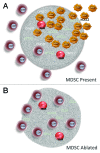Myeloid-derived suppressor sells and the efficacy of CD8+ T-cell immunotherapy
- PMID: 23525353
- PMCID: PMC3601158
- DOI: 10.4161/onci.22764
Myeloid-derived suppressor sells and the efficacy of CD8+ T-cell immunotherapy
Abstract
Myeloid-derived suppressor cells (MDSCs) promote immune evasion, a key feature of oncogenesis. The restoration of immunosurveillance by immunomodulatory antibodies improves the survival of a subset of cancer patients. Preclinical studies suggest that the ablation of monocytic MDSCs may be a useful adjunct to available immunotherapeutic strategies against cancer.
Keywords: CCR2; GM-CSF; adoptive T-cell transfer; immunotherapy; myeloid derived suppressor cells.
Figures

References
-
- Lesokhin AM, Hohl TM, Kitano S, Cortez C, Hirschhorn-Cymerman D, Avogadri F, et al. Monocytic CCR2(+) myeloid-derived suppressor cells promote immune escape by limiting activated CD8 T-cell infiltration into the tumor microenvironment. Cancer Res. 2012;72:876–86. doi: 10.1158/0008-5472.CAN-11-1792. - DOI - PMC - PubMed
Grants and funding
LinkOut - more resources
Full Text Sources
Other Literature Sources
Research Materials
